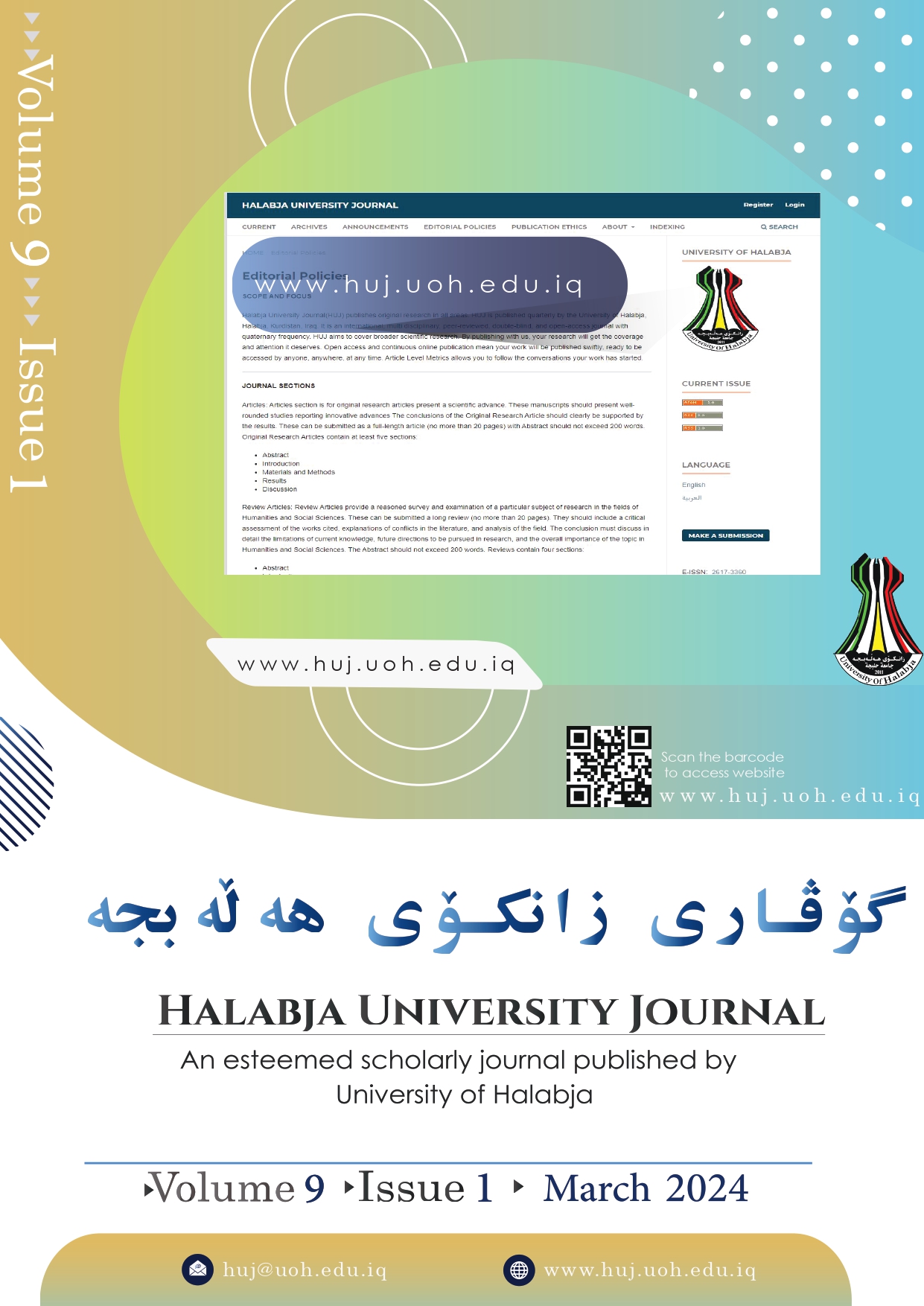ئایا خەرجی سەربازی کاریگەری هەیە لە گەشەکردنی ئابووری لە وڵاتانی تازە پێشکەوتودا؟
هل الانفاق العسكري يؤثرفي النمو الاقتصادى للبلدان الناميه؟
DOI:
https://doi.org/10.32410/huj-10512الكلمات المفتاحية:
خەرجی سەربازی، گەشەی ئابووری، وڵاتانی تازە پێگەشتوو، الإنفاق العسكري، النمو الاقتصادي، البلدان النامیةالملخص
خلال الخمسين عامًا الماضية ، كان هناك كم هائل من الدراسات التجريبية حول تأثير الإنفاق العسكري على النمو الاقتصادي في البلدان النامية ، باستخدام منهجيات وتقنيات ونماذج اقتصادية مختلفة. وعلى الرغم من ان العديد من هذه الدراسات التجريبية تستخدم منهجيات متنوعة خلال العقود الأربعة الماضية ، إلا أنها لا تقدم إجماعًا حاسمًا . لسد الفجوة في الأدبيات ولفحص الآثار الاقتصادية للإنفاق العسكري في 64 بلدًا ناميًا في الفترة من 2017 إلى 2022 ، تستخدم هذەالورقە نموذجًا محددًا وتقدم أدلة تجريبية تستند إليه. وذلك باستخدام تقنيات بيانات اللوحة ، تظهر النتائج بشكل متسق أن هناك علاقة إيجابية بين النمو الاقتصادي والإنفاق العسكري في البلدان النامیە في العينة.
پوختە
لە ماوەی چوار دەیەی ڕابردوودا لێکۆڵینەوەی ئەزموونی زۆر لەسەر کاریگەریی خەرجییە سەربازییەکان لەسەر گەشەی ئابووری لە وڵاتانی تازەپێگەیشتودا ئەنجامدراوە. میتۆدۆلۆژیا و تەکنیک و مۆدێلی ئابووری پێوانی جۆراوجۆر بەکارهێنراون، کە لە ڕێگەی توێژینەوە و پانێڵ داتاکانی نێوان وڵاتانەوە گرنگی بە ٦٤ وڵاتی تازە پێشکەوتوو دراوە. سەرەڕای زۆری و فرەچەشنی ئەم توێژینەوەیە، بەڵگەکان لە سەر بوونی پەیوەندی نێوان (خەرجی سەربازی - گەشەی ئابووری) هێشتا بێ ئەنجامن. ئەوەی جێگەی تێڕامانە، تەنیا ژمارەیەکی سنووردار لە لێکۆڵینەوەکان ئەم پەیوەندییەیان لەناو بواری فراوانی وڵاتانی تازەپێگەیشتودا لێکۆڵیەوە. بۆ چارەسەرکردنی ئەم بۆشاییە، ئەم توێژینەوەیە مۆدێلێکی داتاکانی پانێڵ بەکاردەهێنێت بۆ پێشکەشکردنی تێڕوانینێکی ئەزموونی سەبارەت بە کاریگەرییە ئابوورییەکانی خەرجییە سەربازییەکان لە سەرانسەری 64 تازە پێشکەوتو لە ماوەی 2017-2022. بەگشتی ئەو ئەنجامانەی کە بە بەکارهێنانی شێوازەکانی توێژینەوەی داتاکانی پانێڵ بەدەست هاتوون ئاماژە بەوە دەکەن کە خەرجییە سەربازییەکان بەشدارن لە پێشخستنی گەشەی ئابووری لەو وڵاتانەی کە لە نمونەکەدا هاتووە
المراجع
Aizenman, J. and Glick, R. (2003) Military expenditures, threats, and growth. NBER Working Paper, No. 9618. DOI: https://doi.org/10.3386/w9618
Aizenman, J., and R. Glick. 2006. “Military Expenditure, Threats, and Growth.” The Journal of International Trade & Economic Development 15: 129–155. DOI: https://doi.org/10.1080/09638190600689095
Ali, H. E. (2007). "Military expenditures and inequality: empirical evidence from global data." Defense and Peace Economics 18(6): 519-535. DOI: https://doi.org/10.1080/10242690701331501
Ali, H. E. (2012). "Military expenditures and inequality in the middle east and north africa: A panel analysis." Defense and Peace Economics 23(6): 575-589. DOI: https://doi.org/10.1080/10242694.2012.663578
Baltagi, Badi H., and Young-Jae Chang. 1994. "Incomplete Panels: A Comparative Study of Alternative Estimators for the Unbalanced One-way Error Component Regression
Baran, P.A. and Sweezy, P.M. (1966) Monopoly capital: an essay on the American economic and social order. New York, NY: Monthly Review Press.
Barro, R.J. (1990) Government spending in a simple model of endogenous growth. Journal of Political Economy 98(5) 103–126. DOI: https://doi.org/10.1086/261726
Batchelor, P., P. Dunne, and D. Saal. 2000. “Military Spending and Economic Growth in South Africa.” Defence and Peace Economics 11 (4): 553–571. DOI: https://doi.org/10.1080/10430710008404966
Benoit, E. (1973). "Defense and economic growth in developing countries."
Benoit, E. (1978). "Growth and defense in developing countries." Economic Development and Cultural Change: 271-280. DOI: https://doi.org/10.1086/451015
Birdi, A., and P. Dunne. 2002. “South Africa: An Econometric Analysis of Military Spending and Economic Growth.” In Arming the South: The Economics of Military Expenditures, edited by B. Jurgen and P. Dunne, 220–233. London: Arms Production and Trade in Developing Countries, Palgrave. DOI: https://doi.org/10.1057/9780230501256_10
Biswas, B. and Ram, R. (1986) ME and economic growth in LDCs: an augmented model and further evidence. Economic Development and Cultural Change 34(2) 361–372. DOI: https://doi.org/10.1086/451533
Blundell, R. and S. Bond (1998). "Initial conditions and moment restrictions in dynamic panel data models." Journal of econometrics 87(1): 115-143. DOI: https://doi.org/10.1016/S0304-4076(98)00009-8
Breusch, T. S., and A. R. Pagan. 1980. "The Lagrange Multiplier Test and its Applications to Model Specification in Econometrics." Review of Economic Studies, 47(1):239-253. DOI: https://doi.org/10.2307/2297111
Cuaresma, J., and G. Reitschuler. 2004. “A Non‐Linear Defence‐Growth Nexus? Evidence from the US Economy.” Defence and Peace Economics 15 (1): 71–82. DOI: https://doi.org/10.1080/1024269042000164504
Cuaresma, J., and G. Reitschuler. 2006. “Guns or Butter? Revisited: Robustness and Nonlinearity Issues in the Defense-Growth Nexus.” Scottish Journal of Political Economy 53 (4): 523–541. DOI: https://doi.org/10.1111/j.1467-9485.2006.00393.x
d’Agostino, G., P. Dunne, and L. Pieroni. 2011. “Optimal Military Spending in the US: A Time Series Analysis.” Economic Modelling 28 (3): 1068–1077. DOI: https://doi.org/10.1016/j.econmod.2010.11.021
Deger, S., & Sen, S. (1995). Military expenditures and developing countries. In K. Hartley, & T. Sandler (Eds.), Handbook of defense economics, Vol. 1 (pp. 275–307). Amsterdam, Oxford: Elsevier. DOI: https://doi.org/10.1016/S1574-0013(05)80013-4
Dunne, J. P. (1996). Economic effects of military expenditure in developing countries: A survey. In N. P. Gleditsch (Ed.), The peace dividend (pp. 30–45). Amsterdam: North-Holland.
Dunne, P., & Nikolaidou, E. (1999). Military expenditure and economic growth: A demand and supply model for Greece 1960–96. Defense and Peace Economics, 12, 47–67. DOI: https://doi.org/10.1080/10430710108404976
Dunne, P., and D. Vougas. 1999. “Military Spending and Economic Growth in South Africa: A Causal Analysis.” Journal of Conflict Resolution 43 (4): 521–537. DOI: https://doi.org/10.1177/0022002799043004006
Dunne, P., E. Nikolaidou, and A. Roux. 2000. “Defence Spending and Economic Growth in South Africa: A Supply and Demand Model.” Defence and Peace Economics 11 (4): 573–585. DOI: https://doi.org/10.1080/10430710008404967
Dunne, P., Smith, R. and Willenbockel, D. (2005) Models of military expenditure and growth: a critical review. Defense and Peace Economics 16(6) 449–461. DOI: https://doi.org/10.1080/10242690500167791
Dunne, Paul. (1990) The political economy of military expenditure: an introduction. Cambridge Journal of Economics 14(4) 395–404. DOI: https://doi.org/10.1093/oxfordjournals.cje.a035142
Faini, R., Annez, P. and Taylor, L. (1984) Defense spending, economic structure and growth: evidence among countries and over time. Economic Development and Cultural Change 32(3) 487–498. DOI: https://doi.org/10.1086/451402
Feder, G. (1982) On exports and economic growth. Journal of Development Economics 12 59–73. DOI: https://doi.org/10.1016/0304-3878(83)90031-7
Gelman, A.: Why I don’t use the term “fixed and random effects”. Stat. Model. Causal Inference Soc. Sci. http://andrewgelman.com/2005/01/25/why_i_dont_use/ (2005). Accessed 19 Nov 2015
Geng, L., Abban, O. J., Hongxing, Y., Ofori, C., Cobbinah, J., Ampong, S. A., & Akhtar, M. (2023). Do military expenditures impede economic growth in 48 Islamic countries? A panel data analysis with novel approaches. Environment, Development and Sustainability, 1-35. DOI: https://doi.org/10.1007/s10668-023-03413-8
Greene, William H. 2003. Econometric Analysis, 5th ed. Upper Saddle River, NJ: Prentice Hall.
Halicioglou, F. (2004) Defense spending and economic growth in Turkey: an empirical application of new macroeconomic theory. Review of Middle East Economics and Finance 2(3) 193–201. DOI: https://doi.org/10.2202/1475-3693.1028
Hatzinikolaou, D. (2007) A panel data analysis of the nexus between defense spending and growth in the European Union: a comment. Defense and Peace Economics 18(6) 577–579. DOI: https://doi.org/10.1080/10242690701516804
Hausman, J. A. (1978). "Specification Tests in Econometrics." Econometrica, 46(6):1251-1271. DOI: https://doi.org/10.2307/1913827
Khalid, M. A., & Altaee, H. H. A. (2015). Military spending and economic growth relationship in the case of France, ARDL and causality analysis. Mediterranean Journal of Social Sciences, 6(4), 178.) DOI: https://doi.org/10.5901/mjss.2015.v6n4p178
Khalid, M. A., & Mustapha, A. B. (2014). Long-run relationships and causality tests between military expenditure and economic growth in India. The Economics and Finance Letters, 1(6), 49-58. DOI: https://doi.org/10.18488/journal.29/2014.1.4/29.4.49.58
Khalid, M. A., & Mustapha, A. B. (2014). Military expenditure and economic growth in the case of China: Using ardl approach. International Journal of Development and Emerging Economics, 2(1), 27-36. DOI: https://doi.org/10.18488/journal.29/2014.1.4/29.4.49.58
Khalid, M. A., & Noor, Z. M. (2015). Military expenditure and economic growth in developing countries: evidence from system GMM estimates. Journal of Emerging Trends in Economics and Management Sciences, 6(1), 31-39.
Knight, M., Loayza, N. and Villanueva, D. (1996) The peace dividend: military spending cuts and economic growth. IMF Staff Papers, No. 1577. DOI: https://doi.org/10.2139/ssrn.883201
Kollias, C., et al. (1997). "Defense expenditure and economic growth in the European Union: a causality analysis." Journal of Policy Modeling 26(5): 553-569. DOI: https://doi.org/10.1016/j.jpolmod.2004.03.013
Kollias, C., Mylonidis, N. and Paleologou, S.M. (2007) A panel data analysis of the nexus between defense spending and growth in the European Union. Defense and Peace Economics 18(1) 75–85. DOI: https://doi.org/10.1080/10242690600722636
Lobont, O. R., Glont, O. R., Badea, L., & Vatavu, S. (2019). Correlation of military expenditures and economic growth: lessons for Romania. Quality & Quantity, 53, 2957-2968. DOI: https://doi.org/10.1007/s11135-019-00910-9
Mankiw, N. Gregory, David Romer, and David N. Weil. "A contribution to the empirics of economic growth." The quarterly journal of economics 107, no. 2 (1992): 407-437. DOI: https://doi.org/10.2307/2118477
Model." Journal of Econometrics, 62(2): 67-89.
Mosikari, Teboho Jeremiah, and Keabetswe Matlwa. "An analysis of defence expenditure and economic growth in South Africa." Mediterranean Journal of Social Sciences 5, no. 20 (2014): 2769. DOI: https://doi.org/10.5901/mjss.2014.v5n20p2769
Murdoch, J.C., Pi, C.-R. and Sandler, T. (1997) The impact of defense and nondefense public spending on growth in Asia and Latin America. Defense and Peace Economics 8(2) 205–224. DOI: https://doi.org/10.1080/10430719708404876
Mylonidis, N. (2008) Revisiting the nexus between military spending and growth in the EU. Defense and Peace Economics 19(4) 265–272. DOI: https://doi.org/10.1080/10242690802164801
Negri, C., & Dincă, G. (2023). Russia’s military conflict against Ukraine and its impact on the European Union’s wealth. Can good governance counteract the effects of the war?. Frontiers in Environmental Science. DOI: https://doi.org/10.3389/fenvs.2023.1225793
Pieroni, L. 2009. “Military Expenditure and Economic Growth.” Defence and Peace Economics 20 (4): 327–339. DOI: https://doi.org/10.1080/10242690701589876
Ram, R. (1986) Government size and economic growth: a new framework and some evidence from cross-section and time-series data. The American Economic Review 76(1) 191–203.
Ram, R. (1995). Defense expenditure and economic growth. In K. Hartley, & T. Sandler (Eds.), Handbook of defense economics, Vol. 1 (pp. 251–273). Amsterdam, Oxford: Elsevier. DOI: https://doi.org/10.1016/S1574-0013(05)80012-2
Romer, P.M. (2000) Keynesian macroeconomics without the LM curve. Journal of Economic Perspectives 14(2) 149–169. DOI: https://doi.org/10.1257/jep.14.2.149
Schurer, S., Yong, J.: Personality, well-being and the marginal utility of income: what can we learn from random coefficient models? Working Paper. https://ideas.repec.org/p/yor/hectdg/12-01.html (2012). Accessed 28 Apr 2018
Shor, B., Bafumi, J., Keele, L., Park, D.: A Bayesian multilevel modeling approach to time-series cross-sectional data. Polit. Anal. 15(2), 165–181 (2007). DOI: https://doi.org/10.1093/pan/mpm006
Smith, D. and Smith, R. (1980) Military expenditures, resources and development. Discussion Paper, No.87, November, University of London, Birkbeck College.
Smith, R. and P. Dunne (2001). "Military expenditure growth and investment." Birbeck College and Middlesex University Business School, Abril.
Taylor, J.B. (2000) Teaching modern macroeconomics at the principles level. American Economic Review 90(2) 90–94. DOI: https://doi.org/10.1257/aer.90.2.90
Vaisey, S., Miles, A.: What you can—and can’t—do with three-wave panel data. Sociol. Methods Res. 46(1), 44–67 (2017) DOI: https://doi.org/10.1177/0049124114547769
Wang, Xinyi, Na Hou, and Bo Chen. "Democracy, military expenditure and economic growth: A heterogeneous perspective." Defence and Peace Economics (2022): 1-32. DOI: https://doi.org/10.1080/10242694.2022.2126955
Western, B.: Causal heterogeneity in comparative research: a bayesian hierarchical modelling approach. Am. J. Polit. Sci. 42(4), 1233–1259 (1998) DOI: https://doi.org/10.2307/2991856
التنزيلات
منشور
إصدار
القسم
الرخصة
الحقوق الفكرية (c) 2024 Twana Najaf Mohamad Khan

هذا العمل مرخص بموجب Creative Commons Attribution-NonCommercial-NoDerivatives 4.0 International License.
يوافق المؤلفون الذين ينشرون في هذه المجلة على المصطلحات التالية:
١. يحتفظ المؤلفون بحقوق الطبع والنشر ومنح حق المجلة في النشر الأول مع العمل المرخص له في نفس الوقت بموجب ترخيص المشاع الإبداعي [سيسي بي-نك-ند 4.0] الذي يسمح للآخرين بمشاركة العمل مع الإقرار بحقوق التأليف والنشر الأولي في هذه المجلة.
٢. يمكن للمؤلفين الدخول في ترتيبات تعاقدية إضافية منفصلة للتوزيع غير الحصري للنسخة المنشورة من المجلة من العمل (على سبيل المثال، نشرها في مستودع مؤسسي أو نشرها في كتاب) مع الإقرار بنسخة أولية نشر في هذه المجلة.
٣. يسمح للمؤلفين وتشجيعهم على نشر عملهم عبر الإنترنت (على سبيل المثال، في المستودعات المؤسسية أو على موقعهم على الويب) قبل وأثناء عملية التقديم، حيث يمكن أن يؤدي إلى التبادلات الإنتاجية، فضلا عن الاستشهاد المبكر والأكبر للعمل المنشورة ( انظر تأثير النفاذ المفتوح).





